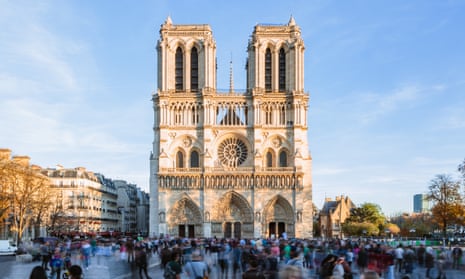Europe’s cathedrals are its wonders of the world. From Salisbury to Seville, Moscow to Palermo, Trondheim to Istanbul, they tower over its cities, masterpieces of art and architecture whose popularity increases by the generation. Even as religious worship continues to decline, attendance at cathedral services has risen by a third in 20 years.
What is it that still draws people to these places? To me the answer transcends faith. It lies in a quest for spiritual and emotional meaning that is found, quite simply, in the beauty of buildings and their decoration. The medieval imagination has an undying appeal today. Everyone should see Europe’s 100 greatest cathedrals before they die. I offer 11 easily reachable ones.
Notre Dame, Paris
Notre Dame rivals St Peter’s in Rome among the most celebrated of Europe’s churches. When a fire broke out in its nave in April 2019, not just France but the world looked on aghast. More than just a building seemed to face obliteration. The famous site on the Île de la Cité has had a church since King Clovis founded Paris in the sixth century, but its rebuilding in 1163 rivalled Chartres in France’s transition to the new gothic style. The 35-metre nave vault was the highest ever built, and the west front was to be dubbed “the tomb of the Romanesque and the cradle of gothic”.
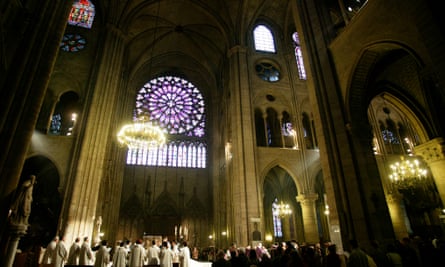
Today Notre Dame’s west front is so familiar people hardly notice its conservative line and formal statuary. It is a formal, rather severe facade that seems to look down at lighthearted Paris with mild disapproval. More of a riot is to be found at the east end, where a giant rose window and parade of flying buttresses are like a galleon trapped on the banks of the Seine.
Inside, the altar depicts Louis XIV paying personal court to Mary and the body of Jesus. During the French Revolution, Notre Dame was so desecrated and neglected that it came close to demolition. Salvation came in the form of a novel, Victor Hugo’s The Hunchback of Notre Dame, which was so popular that its champion Eugène Viollet-le-Duc was able to rescue and restore the cathedral in 1844.
Cologne

The grim towers of Germany’s most magnificent cathedral rise across the North Rhine plain like warnings of impending doom. Closer to, grimness turns to awe. The west front was not completed until the 19th century and much of the exterior is thus neo-gothic. The towers are like waterfalls of black masonry.
Cologne was a site of Roman Christian worship. Its buried baptistery has been dated to the seventh century, its walls still visible in the basement car park. The present cathedral was begun in 1248 in a self-consciously French style, the choir exterior a pack of flying buttresses. Work on the cathedral followed a familiar path, starting at the east end and working west, but ground to a halt in the 16th century. It was not resumed until it served as a symbol of Prussian imperialism under Bismarck.
Architects luckily discovered 14th-century designs for the towers, which became the tallest manmade structure in the world until overtaken in 1884 by the Washington Monument. The cathedral survived 18 direct hits by British and American bombs in the second world war.
Inside, the greatest treasure is a casket of the supposed skulls of the Three Kings, donated by Holy Roman emperor Barbarossa. The casket reliquary is of gold and set with 1,000 precious stones.
Durham
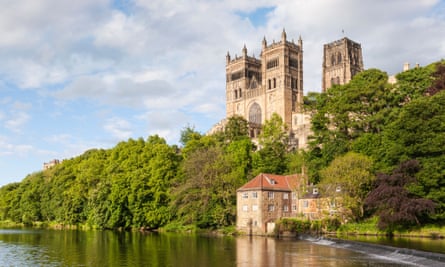
Durham, on its bluff over the River Wear, boasts the finest cathedral site in Europe. It is a Norman giant of a church, William the Conqueror asserting his presence in a hostile land. The Bishop of Durham was granted palatinate powers, allowing him to wage war on rebellious locals without seeking superior authority. The cathedral would have towered over the thatched hovels of medieval Durham like a monster from space.
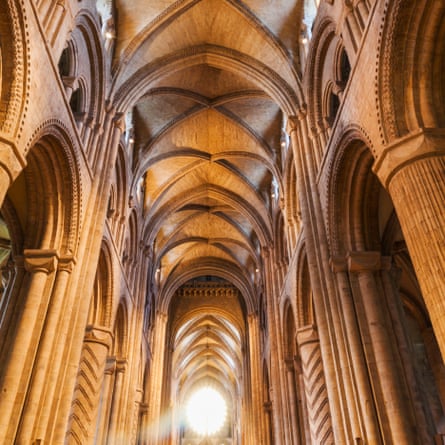
Stylistically the exterior is confusing, since much of what we now see is later perpendicular gothic, but the walls and the ancient sanctuary door knocker survive. A fugitive who grasped it was allowed 37 days of safety inside, to make peace with his enemies or escape.
Durham’s Norman nave is titanic, an avenue of towering trunks, alternately circular and shafted, their piers incised with diapers, spirals and chevrons. A delightful contrast in Romanesque style is offered by the Galilee Chapel, jutting out from the west wall towards the cliff edge. Delicate arches on spindly piers line up in rows, guarding the tomb of the Venerable Bede.
The cathedral’s eastward extension was built to house the supposedly “undecayed” corpse of Saxon Saint Cuthbert. When Henry VIII’s commissioners arrived to destroy it and opened the coffin, they were horrified at the sight of Cuthbert “lying whole with his face bare and his beard as if it had a fortnight’s growth”. They grabbed his jewels and fled.
Milan
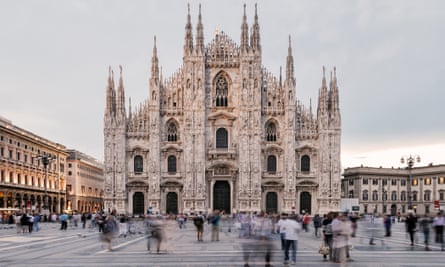
Milan can be an unnerving cathedral. At first sight it is a fizzing tableau of white stone. The west front blazes across the city’s central piazza as backdrop to every Milanese event. This front is not what it seems. The interior of the cathedral was built in the 14th century by French masons for Milan’s ruling Visconti and then Sforza families, intended to outshine Saint Peter’s in Rome. Progress was slow.
The facade had not yet been built when 17th-century fashion demanded a Renaissance style, but only its doors and windows were finished when Napoleon was crowned king of Italy in 1805. Fashion now demanded neo-gothic. The result is a chaotic hotchpotch of buttresses, pinnacles and a reputed 2,245 statues, part gothic, part classical. Like an overdressed model on a Milan catwalk, this cathedral is vulgar to some, glorious to others.
Its interior is colossal. Four rows of 52 massive piers in yellowing Lake Maggiore marble loom over the nave and aisles. A ghoulish (1652) statue in the presbytery of Saint Bartholomew shows him flayed alive, his skin slung over his shoulder like a shawl. In the basement are the remains of a fourth-century Christian baptistery, one of the earliest in existence.
Amiens
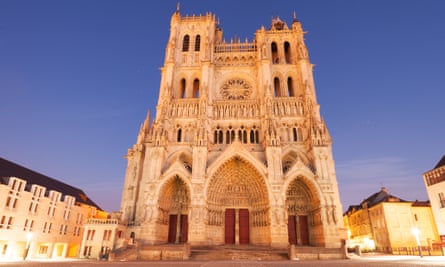
Amiens is the supreme expression of the golden age of French cathedrals. Approached at dusk from the east, with the light dying and its massive outline sinking into silhouette, its gothic engineering strains every sinew. Flying buttresses are interspersed with crouching chapels like the launchpad for a moon rocket. In the building frenzy of the 1220s, its architect, Robert de Luzarches, was commanded to outdo Paris, Chartres and Rheims and erect the highest vault in the world. Ruskin called it “the flower of Picardy”. The west front is Amiens’ masterpiece, the balance of its components faultless. The lower stage is formed of the customary three doorways, their canopies projecting outwards, their bases crowded with statues. I watched it one night bathed in son-et-lumière, lasers lighting each gable, niche and statue and dancing them across the facade. The rose window morphed into a bunch of flowers. Finally every carved detail was depicted in colour, as would have been the original.
Amiens’ interior is a symphony of height and light. In the south transept stands the celebrated Golden Virgin, with Mary’s torso twisted to hold her baby on her hip. An even greater treat lies in the choir stalls, where Bible stories are mixed with scenes of daily life: farmers, milkmaids, butchers, wives beating husbands (never the reverse) and portraits of the carvers themselves, across an astonishing 3,600 panels.
’s-Hertogenbosch

Its name usually shortened to Den Bosch, this is a relaxed Dutch canalside town. Nowhere seems a more unlikely home for the medieval artist Hieronymus Bosch (1450-1516) or for the cathedral from which he allegedly drew inspiration. It is the star of Dutch churches.
The cathedral is essentially French, albeit in a flamboyant variant known as Brabantine gothic. Its principal feature is the astonishing carvings over its exterior. Roof ridges, pinnacles and niches carry about 600 medieval figures. Angels and bishops cavort with monsters, ghouls, masons and townsfolk clinging to every inch.
The master of all this was a 15th-century architect/sculptor called Alaert du Hamel, a contemporary of Bosch. Extant prints by him of heaven and hell are remarkably similar to Bosch’s more fantastical works, as are his characters on the cathedral exterior. In 1997 a local sculptor replaced a medieval angel with a winged girl in jeans and sweatshirt holding a mobile phone. The phone is said to have just one button: “To God”.
Strasbourg

Strasbourg was monarch of the Upper Rhine, sharing that river’s long and troubled history. Capital of Alsace-Lorraine, it was long contested between France and the German states. Seized by Germany in the second world war, it was duly flattened by allied bombs in 1944. The postwar reconstruction of the old town was meticulous and held the key to its present prosperity. Its battered cathedral now gazes down on strolling members of the European parliament.
In 1176 a cathedral in the Romanesque style was begun by masons from Chartres, but in 1225 the fashion-conscious canons told them to switch to gothic. The resulting massive west front is the ultimate assertion of medieval “skyscraper” gothic, a see-through filigree of lightweight tracery allowing ever greater height.
Strasbourg’s magnificent medieval glass was mercifully hidden in a salt mine during the war, as was its outstanding possession, a 16th-century clock. Made in 1547 and now located in the south transept, it was made by craftsmen listed as watchmakers, mathematicians, architects and painters. Rebuilt three centuries later, its working parts still emerge from their niches to mark the hours, months and seasons. A solar system charts the equinoxes and includes a wheel said to take 25,806 years to rotate. I wonder who is counting.
Ely
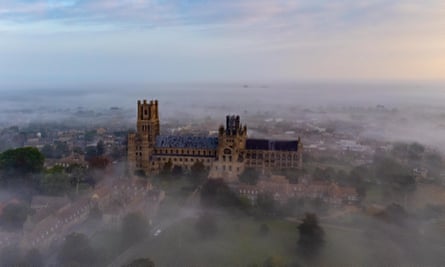
Ely is often pictured floating across the Fens like a ghostly ship. The original abbey was founded in the seventh century by England’s first female saint, Etheldreda, a princess who rejected consummation in not one but two arranged marriages.
The Norman abbey was a focus for pilgrimage but suffered a catastrophe in 1322 when the great crossing tower collapsed, taking with it three bays of the choir. The prior, Alan of Walsingham, “grieved vehemently and was overcome with sorrow”. But he blessed Ely with its most outstanding treasure: the replacement octagonal tower and lantern.
The Norman nave might be a phalanx of conquering knights. There is no ornament, just a rhythmic alternation of rounded and shafted piers. But visitors should walk it with caution. The transition from nave into crossing offers a visual sensation hardly equalled in gothic architecture. Alan of Walsingham’s crossing vault leaps upwards into space, exploding into fans round the lantern opening. We can climb the lantern and look out across the Fens. On a misty day the sense is even stronger of being lost on a ship at sea.
Sagrada Familia, Barcelona
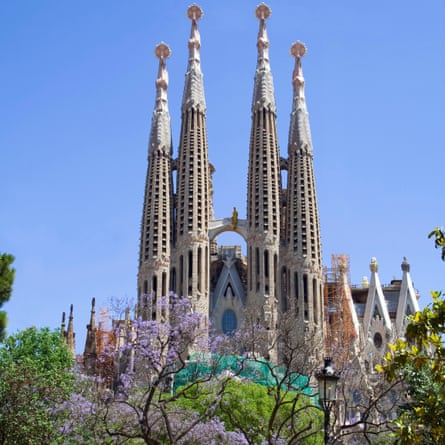
Though not (yet) a cathedral, Barcelona’s Sagrada Familia is one in all but name. When I first visited it years ago there was only a shell of half-finished walls and spires under scaffolding. Today it is almost complete and one of the most remarkable gothic structures in Europe. The interior is a soaring edifice of ribs and piers, striding, tilting, swooping and leaping, dazzled by slashes of coloured glass. For the visitor the problem is to find space on the floor to lie down and look up, so crammed is it with visitors.
The church was projected by an eccentric Catalan publisher, Josep Bocabella, and designed by the young and deeply pious Antoni Gaudì in 1883. He saw it as an assertion of traditional Catholicism against modernism and democracy. The building was nowhere near finished when, in 1926, Gaudì was killed by a Barcelona tramcar. He believed, rightly, that natural forms held the key to gothic design. Nature was “the Great Book, always open, that we should force ourselves to read”.
At first sight the exterior has an excess of folksy romance, its gaping fantasy portals as if by Disney out of Tolkien. Two towers remain to be built, planned as the tallest on any church anywhere. Their bells are to be rung by nature’s passing wind.
Exeter
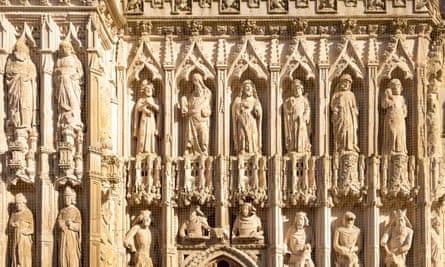
Exeter cathedral is architecture as theatre, the carved figures on its golden west front coming to life at sunset. The original Saxon cathedral was rebuilt by the Normans in 1112, and the twin towers of this building remain as the city’s signature. The rest of the cathedral was rebuilt in the flamboyant style of English Decorated, financed by the first “income tax”, levied on local clergy.
The interior arcades are a feast of clustered columns, carrying the eye rhythmically down a hundred metres of what is supposedly the longest unbroken vault in existence.
Down the centre of the vault run Exeter’s celebrated carved roof bosses, depicting monarchs, bible scenes and hellish monsters. A gruesome death of Thomas Becket has a sword buried in his head. In the north transept is a medieval catflap, the cat being paid a penny a week to kill vermin.
In Exeter choir stands the giant bishop’s throne: to Nikolaus Pevsner it was “the most exquisite piece of woodwork of its date in England, perhaps in Europe”. Every feature strains upwards, the multi-lobed arches, nodding ogees, crockets, balls, vine leaves, grapes and human faces. A corbel high on the wall opposite is a rare sheela-na-gig, a woman exposing her genitals, whether to promote fertility or to mock the chastity of the monks below is not known.
Exeter’s retrochoir was fortunate in the last century to receive the attention of the art historian and conservator Ernest William Tristram. A specialist in medieval paintwork, he was able to restore colour to walls, vaults and carvings before the purists opposed such embellishments. England’s colourless cathedrals need him back.
Antwerp

Antwerp was a fragmentary relic of Charlemagne’s empire that for centuries was an open city to merchants and refugees from all Europe. It was Frankish, Flemish, Burgundian, Spanish, Dutch and French. By the first half of the 16th century, this made it the largest port in northern Europe. In 1477 it passed by marriage into the Holy Roman empire under the Spanish crown, leading to the Spanish Inquisition, rebellion and disaster. The cathedral tells of Antwerp’s greatest days, the magnificent 123-metre tower still rising over what remains of the ancient city. It contains no fewer than 49 bells. The gothic interior is a hall of light, the vast seven-aisled nave reputedly holding a congregation of 25,000. Arcades rise to gracefully undulating arches, naked of capitals, the upper stages forming a majestic greenhouse.
The cathedral is a gallery of works by the city’s distinguished son, Peter Paul Rubens, and his contemporaries. They were looted by Napoleon in 1803 but later returned, and are beautifully distributed above altars and against columns.
This article was amended on 23 November 2021 because an earlier version referred to Cologne cathedral’s treasure of a casket of skulls which “are in solid gold and set with 1,000 precious stones”. It is the casket reliquary which is of gold and set with stones.
Europe’s 100 Best Cathedrals by Simon Jenkins is published this month by Penguin/Viking (£30). To order a copy for £26.10, including UK p&p, visit guardianbookshop.com
